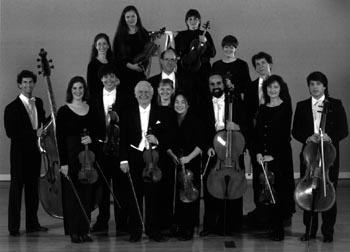
Waiting for the Millennium: The New Century Chamber Orchestra.
The New Century Chamber Orchestra shines in season opener
By Philip Collins
The New Century Chamber Orchestra heralded the coming of 1998 with a season opener of consequence and charm last weekend. As is now traditional for the six-year-old, Grammy Award-winning string orchestra, repeat performances of the program were given in four Bay Area locations: Berkeley, Palo Alto, San Francisco and San Rafael.
Last Friday's (Dec. 19) concert at First United Methodist Church in Palo Alto featured the orchestra at the top of its game with a program that was made to please. Handel's Concerto Grosso in D Major, Opus 6, no. 5 and Walton's Sonata for String Orchestra showed off the group's collective artistry. Impeccable ensemble and timbres of luxuriant richness brought these two marvels to ripe fruition. Mozart's Piano Concerto no. 12 in A, K.414 also highlighted the orchestra's virtues, but the addition of celebrated 25-year-old virtuoso Rieko Aizawa proved more a bane than a blessing.
A glance at Aizawa's bio led one to think that New Century had pulled off a real coup by booking the one-time child wonder. The reverse was more the case.
After making headlines at the age of 16 with a critically acclaimed performance of this same Mozart concerto at Carnegie Hall, Aizawa went on to collaborate with a number of renowned artists such as Richard Stolzman, the Guarneri String Quartet and many of the world's most respected orchestras. This impressive résumé seemed to indicate that she had transcended the child-prodigy syndrome and flowered into musical adulthood.
Her performance of the Mozart, alas, did not bear this hope out. It was hardly expected that technical issues would get in the way, but the passagework was inadequately addressed in a number of instances. Aizawa's renderings were tepid and always catching up rather than leading somewhere, a discrepancy that her excessive pedaling did little to conceal.
The concerto's expressive aim was seldom supported by the soloist either. The work's predominant cheeriness was voiced well enough, but Aizawa's playing merely hinted at the music's delicious turns into deeper emotional spheres.
A Handel High
Handel's exuberant concerto raised the evening's curtain in grand fashion. The succinct yet powerful impact of the score depends upon an appealing blend of technical facility and dramatic candor, both of which New Century championed with unflagging industry and rapport.
In the second slot, Walton's Sonata provided a fitting response to the Handel. Despite the 230-year gap dividing the creation of these two works, they proved surprisingly akin to one another. Like the Handel, Walton's Sonata follows a rigorous, concisely mapped schedule of independent movements. Both pieces remain vigorously contrapuntal from start to finish, which the exception of the presto movement, whose sheer contours featured the orchestra in unified rhythms and darted about as elfinlike and magical as anything Mendelssohn ever penned (well, almost).
The varied harmonies of Walton's mildly contemporary syntax (based largely on the interval of the 4th) were rendered with utmost consonance by the orchestra, whose precise tuning in turn added real teeth to the poignant, more biting dissonances of the lento movement, which was elegiac in mood and richly varied in texture. Phrases evocative of lamentation passed from one section to another, amid an atmosphere of communal focus. The movement had that characteristic balance of rigor and gentility that the English manage so well, and the orchestra responded most movingly.
An English Ride
The closing allegro molto was a wicked romp over the English countryside, rife with rhythmic chuckholes and the like, all of which the orchestra navigated confidently, with panache intact.
The Walton score benefited--as did the Mozart and Handel--from the best of two worlds. While according each piece the lush, full sonorities of an orchestra, this conductorless outfit also brings the intimacy of chamber music to its every undertaking.
In merely six years, the New Century Chamber Orchestra has had a sweeping impact upon the Bay Area's musical life. Under the spirited guidance of music director/concertmaster Stuart Canin, the ensemble has brought a largely neglected repertoire to our door steps. And it has done so with a refreshing approach to concert giving.
The orchestra's practice of offering multiple performances of concerts at different locations throughout the Bay Area has proven a worthwhile strategy (as evinced by the fact that the Philharmonia Baroque Orchestra and other groups are now following suit). Audiences continue to grow and the performances ripen with each reprise: an optimum scenario, indeed.
Also, the New Century Chamber Orchestra program books amends the players' "professional" biographic sketches with individually written essays. This practice enriches the relationship between performers and audience.
[ San Jose | Metroactive Central | Archives ]
![[Metroactive Music]](/music/gifs/music468.gif)